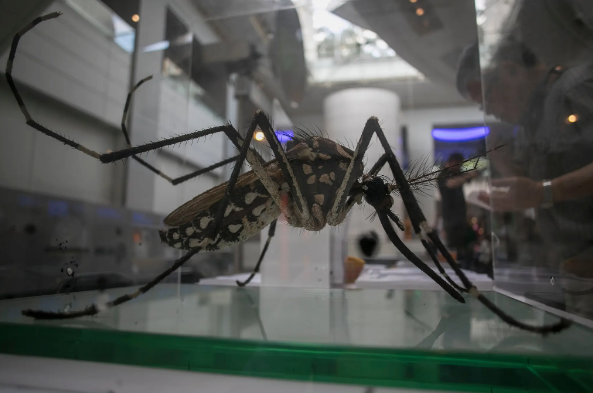我们通过发表论文来表彰学生 STEM 写作比赛的前八名获奖者。这是Pyncha Soottreenart的作品。

信用。。。维克多·布鲁(Victor J. Blue)为《纽约时报》撰稿
She, the killer from team Mother Nature. Bearing the weapon that pierced and murdered 52 billion humans throughout history. She is the number one source of suffering to mankind: She is the mosquito.
A red, itchy swelling is the only evidence a female mosquito leaves at the crime scene. When sucking blood, it pierces six needles (known as the proboscis) into our skin. Despite the act sounding rather painful, mosquitoes are hardly caught red-handed in the act. Why?
It’s not about being the strongest, but the smartest. The tip of the proboscis is soft, thus a third of the pressure is needed to penetrate the skin compared to a normal needle. Instead of using a large force, vibration motions at a frequency of 15-hertz are used. Less skin deformation occurs, hence fewer pain signals are transmitted from the area to alert us of the mosquito’s arrival.
When drawing blood out of our vessels, mosquitoes completely mask the pain when doing so. After the proboscis has been inserted into the skin, the sixth needle (the hypopharynx) releases a numbing agent in the saliva. This acts as an anaesthetic — completely silencing pain receptors from sending messages to the brain. So perhaps mosquitoes care about hurting us? No. Do not thank these insects. This tactic allows them to avoid getting crushed by our fists. Furthermore, the saliva may also contain parasites and pathogens, which cause the deadly diseases that kill over a million humans each year.
Mosquitoes will continue to be the villains in history. However, there is a silver lining. Recent advancements in mimicking the proboscis provide exciting innovations for the medical field.
“We can use what we have learned from mosquitoes as a starting point to create a better microneedle,” explained Bharat Bhushan, an engineer from Ohio State University who is the co-lead author of a study on developing a painless microneedle. The team’s proposal is to create a double needle. One needle will inject a numbing agent, and the second can be used to either draw blood or inject a drug. The design of the second needle will mimic the proboscis: a serrated shape, soft at the tip, that enters the skin through vibration. These mechanisms will make injections painless, and may eliminate the universal fear of long, sharp, pointy needles at the doctor’s office for good.
Here is another example: Back in 2020, an article by a team from the University of Michigan was published about the possibility of using proboscis-inspired needles to extract tissues during biopsy. The needle will cause less tissue deformation, so targeting tissues from cancerous regions will be easier. Therefore, cancer diagnosis becomes more accurate.
Ultimately, through evolution, nature has created functionality for life. Biomimicry provides a promising guide to progression in not only the field of medicine, but beyond. Perhaps it is time we unwrap the hidden gifts nature has provided to catapult human advancement, rather than simply perceiving them as a threat to mankind.
Works Cited
Dumé, Belle. “Painless Needle Mimics a Mosquito’s Bite.” New Scientist, 17 July 2008.
Li, Annie D. R., et al. “Mosquito Proboscis-Inspired Needle Insertion to Reduce Tissue Deformation and Organ Displacement.” Scientific Reports, 22 July 2020.
“Mosquito Bite Helps Create the Ideal Injection Needle.” De Engineur, 29 June 2018.
Reese, Hope. “Mosquitoes Might Be Humanity’s Greatest Foe. Should We Get Rid of Them?” Vox, 21 Aug. 2019.
Schroeder, Jackson. “Mosquitos Hold The Secret to Painless Needles.” The University Network, 2018.
Winegard, Timothy C. “The Mosquitoes Are Coming for Us.” Editorial, The New York Times, 27 July 2019.